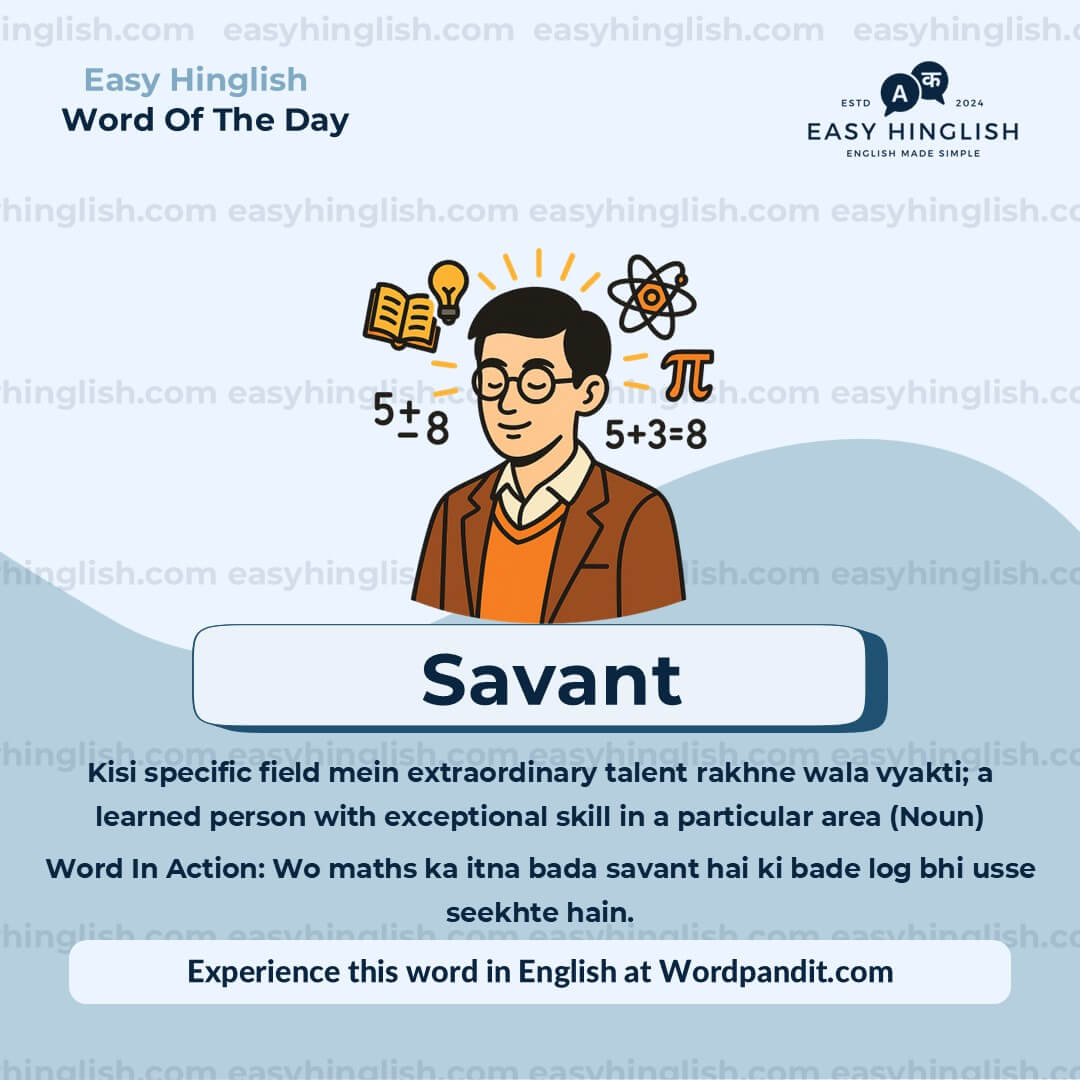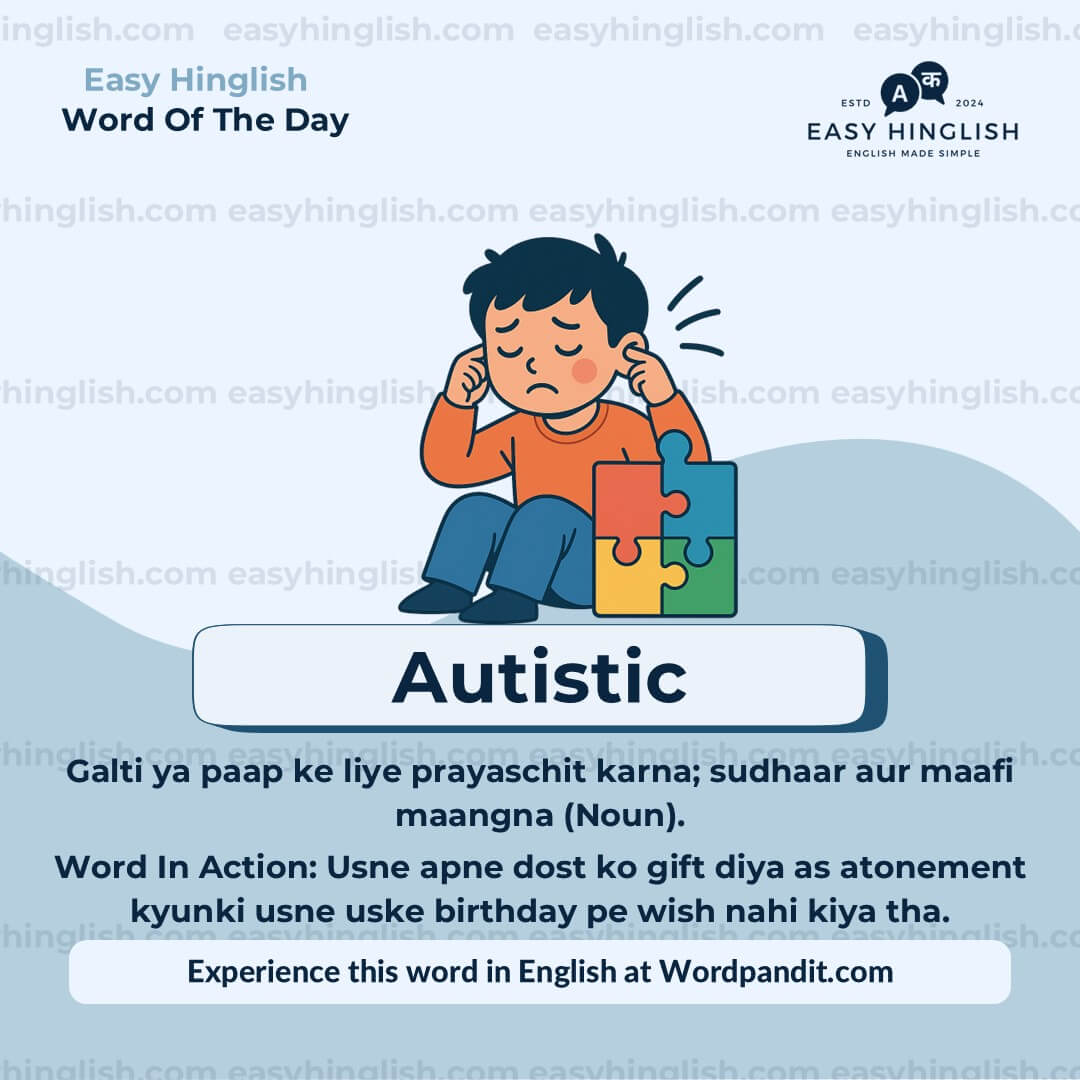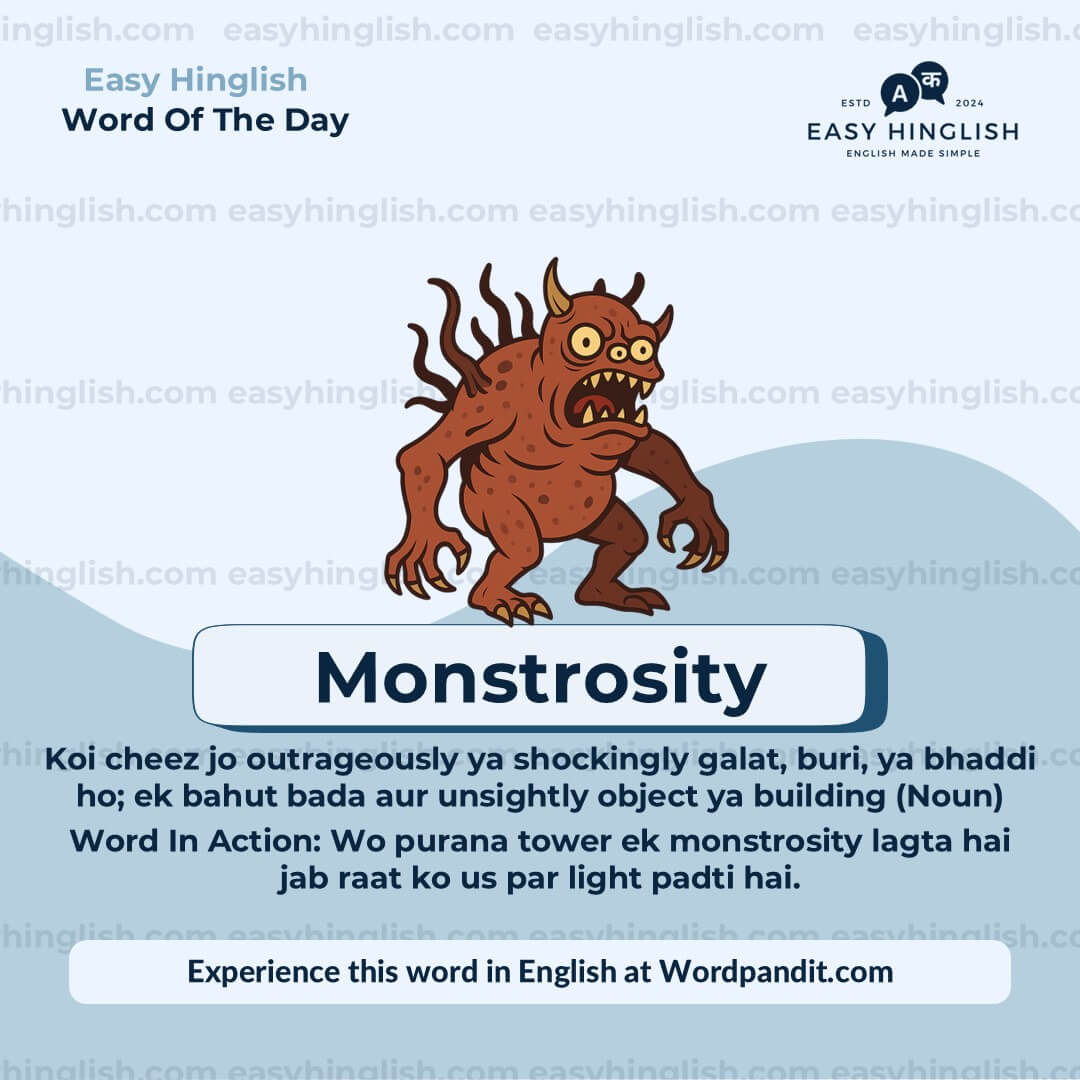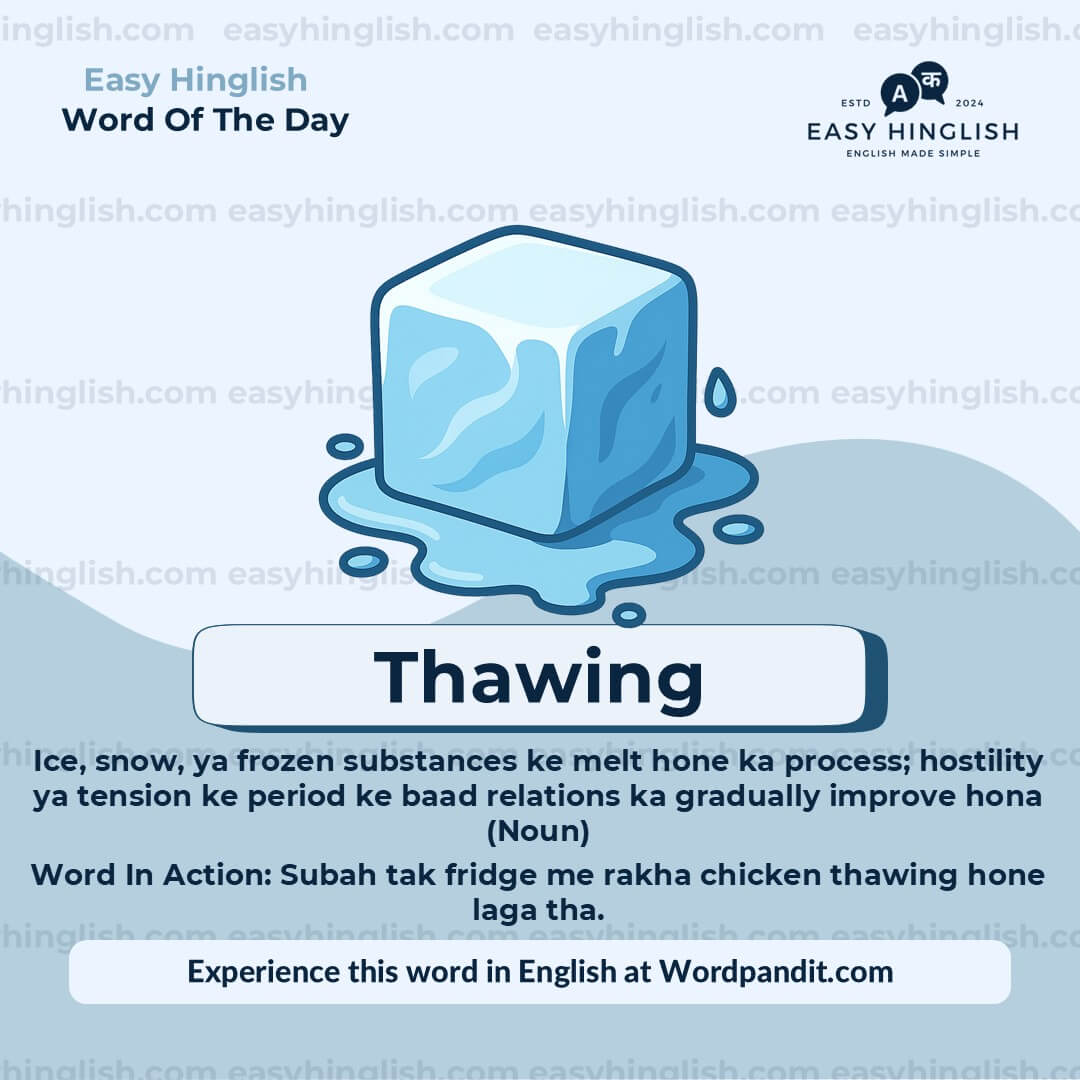Daily Vocabulary International Newspapers aur Publications se Seekho
Wordpandit ke Global Vocabulary Hub ke Saath Apni Vocabulary Expand Karo
Wordpandit par, hum aapko ek truly global vocabulary develop karne me madad karte hain, jo duniya ke sabse respected international publications se li gayi hoti hai. Yeh section aapko naye words se introduce karne ke liye design kiya gaya hai jo global conversations aur trends ko define karte hain.
Global Sources ka Power
Aapko globally sochne aur communicate karne me madad dene ke liye, hum vocabulary curate karte hain world ke top international sources se, jaise:
- The New York Times
- The Washington Post
- BBC
- The Guardian
- The Economist
- Scientific American
- Psychology Today
- Aur bhi bahut saare...
Globally Socho, Competitively Seekho
Hamare daily updates se aap international publications ke naye words seekhoge jo global news aur developments se jude hote hain. Isse aapki vocabulary current bhi rahegi aur globally relevant bhi.
Apni Global Soch Ko Expand Karo
Agar aap international exams ki tayari kar rahe ho, global business communication me excel karna chahte ho, ya sirf apni language skills improve karna chahte ho, toh Wordpandit aapko global level pe grow karne ke liye best resources provide karta hai.
Smart Learning, Global Reach
Hamari learning methodology me global examples, memory aids, aur interactive activities shamil hain, jo naye words ko effectively yaad karne aur real-world me use karne me madad karti hain.
Aaj Hi Apni Global Vocabulary Journey Shuru Karo!
Wordpandit Kyun Choose Karein?
Practical Learning: Aise words seekho jo real-world reading aur communication me aapko sach me kaam aayenge, taaki aapki comprehension aur bolne ki skills improve ho.
Diverse Content: Current affairs se lekar scientific breakthroughs tak, hamare different sources aapko multiple domains ki vocabulary seekhne ka moka dete hain.
Effortless Integration: Wordpandit ko apni daily routine ka part banao. Sirf kuch minute har din dene se aapki vocabulary time ke saath kaafi improve ho sakti hai.
Vocabulary Mastery Tak Ka Aapka Safar
- Regularly hamare Daily Vocabulary section ko visit karo
- Naye words explore karo aur unka context me use samjho
- In words ko apni writing aur bolne ki practice me use karne ki koshish karo
- Jaise-jaise aapke words badhte hain, apni progress ko track karo
Aaj Hi Apni Vocabulary Journey Shuru Karo!
Wordpandit ke saath vocabulary improve karna start karo. Roz thoda effort dalne se aap ek strong vocabulary develop kar sakte ho jo academic, professional, aur personal life me kaafi kaam aayegi.
Yaad rakho, ek naya shabd roz seekhna linguistic limitations ko door karne ka best tareeka hai! Wordpandit ko apni daily learning journey ka sathi banao aur vocabulary excellence ki taraf badho!
WORD-1: Savant
Sandarbh (Context):
"The answer took the form of a medical label: the boy was what 19th-century medicine termed an 'idiot savant'." - Aeon
Vyakhya (Explanatory Paragraph):
Savant ka matlab hai ek aisa vyakti jo kisi particular field mein exceptional talent ya extraordinary skills rakhta hai, chahe overall intelligence average ya below average ho. Yeh word tab use hota hai jab kisi insaan mein ek specific area mein genius-level ability ho—jaise music, mathematics, art, ya memory—lekin dusre normal tasks mein struggle karta ho. Savant ko psychology, medical literature, aur competitive exam passages mein use karte hain jab extraordinary human capabilities aur brain functioning ki complexity discuss karni ho. CAT aur GRE reading comprehension mein yeh word aksar neuroscience ya human potential ke context mein milta hai.
Arth (Meaning): Kisi specific field mein extraordinary talent rakhne wala vyakti; a learned person with exceptional skill in a particular area (Noun)
Uccharan (Pronunciation): sa-VAHNT / सवाँ
Kathinai Star (Difficulty Level): ⭐⭐⭐ Intermediate se Advanced
Utpatti (Etymology): Savant French word 'savoir' se aaya hai jiska matlab hai 'to know' ya 'jaanna.' Originally yeh word learned scholars aur knowledgeable logon ke liye use hota tha. 19th century mein medical science ne 'idiot savant' term introduce kiya un logon ke liye jo cognitive disabilities ke saath extraordinary abilities rakhte the. Aaj kal hum respectfully sirf 'savant' ya 'savant syndrome' kehte hain.
Prashant Sir Ke Tathya (Prashant Sir's Notes):
Bahut students savant ko simply 'expert' ya 'genius' samajh lete hain, lekin savant aur genius mein bada farak hai. Savant ka sahi istemal kaise karein: yeh specifically un logon ke liye use hota hai jinmein cognitive limitations ke bawajood exceptional abilities hoti hain—jaise Dustin Hoffman ki film 'Rain Man' mein. CAT aur GRE ke psychology ya neuroscience passages mein savant syndrome aksar example ke roop mein aata hai jab brain plasticity ya specialized intelligence discuss hoti hai. Indian context mein, jab aap kisi ke baare mein bolte ho jo academically weak hai lekin music ya painting mein brilliant hai, tab 'savant-like abilities' appropriate term hoga.
Samanarthi & Vipritarthi (Synonyms & Antonyms):
Samanarthi (Synonyms): prodigy, genius (specific context mein), expert, virtuoso, master, specialist, scholar, maven
Vipritarthi (Antonyms): amateur, novice, layman, beginner, ignoramus, dabbler
Udaharan (Usage Examples):
- Mumbai ke ek musical savant ne apni extraordinary piano skills se international competitions jeetne ke bawajood daily life tasks mein support ki zaroorat hai.
- Rohan ek mathematical savant hai jo complex calculations seconds mein solve kar leta hai, lekin simple social interactions use mushkil lagte hain.
- Documentary ne dikhaya ki kaise kuch savants apni photographic memory use karke poore city maps detail mein draw kar sakte hain.
- Dr. Sharma ne conference mein explain kiya ki savant abilities brain ki neuroplasticity aur compensatory mechanisms ka example hain.
Sanskritik Sandarbh (Cultural Reference):
"Bollywood film 'My Name is Khan' mein Rizwan Khan ek savant character tha jiska Asperger's syndrome tha lekin extraordinary mechanical aur pattern recognition abilities thi—yeh portrayal savant syndrome ki public understanding badhane mein helpful raha." - Film analysis
Sochiye (Think About It):
Kya society savants ki extraordinary talents ko properly recognize karti hai, ya sirf unki limitations par focus karti hai? Kaise hum education system ko inclusive bana sakte hain taaki savant-like abilities wale students shine kar sakein?
Chhoti Kriya (Quick Activity):
YouTube par kisi famous savant—jaise Stephen Wiltshire (artist savant) ya Daniel Tammet (mathematical savant)—ka video dekhein aur notice karein ki unki abilities kaise extraordinary hain. Do sentences likhein describing what impressed you most.
Yaad Karne Ka Tarika (Memory Tip):
'Savant' ko aise yaad rakhein: 'SAV-ANT'—imagine karo ek CHINTI (ANT) jo apna ghar SAVE karne ke liye extraordinary engineering skills use kar rahi hai, lekin dusri simple tasks nahi kar sakti. Yeh contrast savant ki defining quality hai—exceptional ability in one area despite limitations elsewhere.
Vastavik Jeevan Me Upyog (Real-World Application):
Psychology articles, medical journals, aur special education literature mein 'savant' commonly use hota hai exceptional human capabilities describe karne ke liye. Educational professionals aur therapists iska use karte hain jab individualized learning plans design kar rahe hon jo savant-like abilities ko nurture karein. Competitive exam essays mein, jab neuroscience, human potential, ya inclusive education discuss karna ho, tab savant syndrome perfect example ban sakta hai ki kaise human brain extraordinary adaptation kar sakta hai.
WORD-2: Autistic
Sandarbh (Context):
"Treffert (1933-2020), one of the leading experts in the field – defines the savant phenomenon as 'a rare condition in which persons with various developmental disorders, including autistic disorder, have an amazing ability and talent'." - Aeon
Vyakhya (Explanatory Paragraph):
Autistic ka matlab hai autism spectrum disorder se related ya affected—ek developmental condition jo social communication, behavior patterns, aur sensory processing mein differences se characterize hoti hai. Yeh word tab use hota hai jab autism spectrum disorder wale individuals ya is neurological condition se judi characteristics describe karni ho. Autistic kaise use karte hain yeh sensitivity aur respectful language require karta hai, aur yeh term medical literature, educational contexts, psychology articles, aur neurodiversity discussions mein frequently appear hota hai. CAT aur UPSC ke passages mein autistic aksar special education, social inclusion, aur diverse cognitive styles ke context mein milta hai.
Arth (Meaning): Autism se related ya autism spectrum disorder wala vyakti; neurological condition jo social communication aur behavior patterns mein differences dikhata hai (Adjective)
Uccharan (Pronunciation): aw-TIS-tik / ऑटिस्टिक
Kathinai Star (Difficulty Level): ⭐⭐ Basic se Intermediate
Utpatti (Etymology): Autistic Greek word 'autos' se aaya hai jiska matlab hai 'self' ya 'khud,' combined with suffix '-istic.' Yeh term 1912 mein Swiss psychiatrist Eugen Bleuler ne coin kiya tha, jinhone 'autism' ka use kiya self-absorbed behavior describe karne ke liye. 1943 mein Leo Kanner ne is term ko specifically children ke liye apply kiya jo developmental differences dikhate the social interaction aur communication mein. Modern understanding mein autism ek complex neurological variation hai jo diverse presentations ke saath aata hai.
Prashant Sir Ke Tathya (Prashant Sir's Notes):
Students aksar poochhte hain: autistic aur autism mein kya farak hai? 'Autism' noun hai jo condition ko name karta hai, jabki 'autistic' adjective hai jo kisi person ko describe karta hai jo autism ke saath hai. Autistic aur autism mein farak samajhna UPSC aur CAT essays ke liye important hai. CAT RC passages mein autistic frequently neurodiversity, education policy, aur social inclusion ke context mein aata hai. Indian English mein aapko dono 'autistic person' (identity-first language jo community prefer karti hai) aur 'person with autism' (person-first language) milenge. Competitive exam essays mein respectful, neutral language use karein jo autism ko neurological difference ke roop mein recognize kare, deficit ke roop mein nahi.
Samanarthi & Vipritarthi (Synonyms & Antonyms):
Samanarthi (Synonyms): on the spectrum (informal), neurodivergent (broader term), having autism spectrum disorder (clinical), neuroatypical (general term)
Vipritarthi (Antonyms): neurotypical, allistic (technical term for non-autistic), typically developing
Udaharan (Usage Examples):
- Bangalore ke school ne ek special program shuru kiya autistic children ko support karne ke liye taaki woh social aur communication skills develop kar sakein academic studies ke saath.
- Rohan ek autistic software engineer hai jo pattern recognition aur debugging code mein excel karta hai, apni tech company ki development team mein unique strengths laate hue.
- Bahut autistic individuals mein sensory sensitivities hoti hain jo crowded places jaise Mumbai local trains ko particularly overwhelming aur challenging bana deti hain.
- Documentary ne explore kiya ki kaise India mein autistic adults employment discrimination face karte hain despite having valuable skills aur perspectives jo workplaces ko contribute kar sakte hain.
Sanskritik Sandarbh (Cultural Reference):
"Autism ko samajhna kisi ko 'fix' karne ke baare mein nahi hai—yeh duniya ko experience karne ke different tareeqon ko accept karne ke baare mein hai." - Neurodiversity advocacy ka common perspective, jo films jaise 'My Name is Khan' mein bhi reflect hota hai
Sochiye (Think About It):
Indian society ko autism ke baare mein better awareness ki zaroorat kyun hai, aur kaise workplaces aur educational institutions autistic individuals ke liye zyada inclusive environments create kar sakte hain?
Chhoti Kriya (Quick Activity):
Do sentences likhein describing ki India mein schools ya workplaces autistic students ya employees ko kaise better support kar sakte hain, practical accommodations aur inclusive practices par focus karte hue.
Yaad Karne Ka Tarika (Memory Tip):
'Autistic' ko aise yaad rakhein: 'AUTO-STICK' samajho—jaise kuch logon ka brain 'AUTO' mode par hai jo certain patterns, routines, aur information processing ke tareeqon par 'STICK' karta hai jo typical development se different hote hain.
Vastavik Jeevan Me Upyog (Real-World Application):
Medical reports, educational assessments, psychology research, aur special education se related policy documents mein 'autistic' commonly use hota hai. Journalism aur feature writing mein yeh term neurodiversity, inclusion, aur mental health awareness ke articles mein appear karta hai. Competitive exam essays aur answers ke liye 'autistic' samajhna essential hai jab education policy, social inclusion, healthcare accessibility, aur workplace diversity discuss karni ho. Indian discourse mein yeh term increasingly important ho raha hai jaise developmental differences ke baare mein awareness badh rahi hai aur schools, colleges, aur professional environments mein inclusive practices ki zaroorat recognize ho rahi hai.
WORD-3: Monstrosity
Sandarbh (Context):
"In the scheme of how intelligence was understood then, the savant was at best otherworldly and at worst a monstrosity." - Aeon
Vyakhya (Explanatory Paragraph):
Monstrosity ka matlab hai koi aisi cheez jo shockingly ugly, galat, ya unnatural ho—ek outrageous ya horrifying cheez ya vyakti. Yeh word tab use hota hai jab kuch itna grotesque, morally offensive, ya abnormal ho ki woh shock ya disgust produce kare. Monstrosity ko literary criticism, social commentary, historical discussions, aur competitive exam passages mein use karte hain jahan authors strong disapproval express karein ya kisi cheez ko fundamentally wrong ya distorted beyond acceptable limits describe karein. CAT aur GRE reading comprehension mein monstrosity aksar author ke strong negative judgment ko signal karta hai.
Arth (Meaning): Koi cheez jo outrageously ya shockingly galat, buri, ya bhaddi ho; ek bahut bada aur unsightly object ya building (Noun)
Uccharan (Pronunciation): mon-STROS-ih-tee / मॉन्स्ट्रॉसिटी
Kathinai Star (Difficulty Level): ⭐⭐⭐ Intermediate
Utpatti (Etymology): Monstrosity Latin word 'monstrum' se aaya hai jiska matlab hai 'divine omen, portent, ya monster,' jo khud 'monere' se derive hua hai matlab 'warn karna.' Ancient times mein unusual births ya phenomena ko gods ki warnings samjha jata tha. Yeh word Old French 'monstruosité' ke through 16th century mein English mein aaya. Originally yeh beings ya things ke liye use hota tha jo natural order ko defy karti thi, lekin monstrosity evolve hokar ab kuch bhi shockingly abnormal describe karta hai—physically grotesque, morally repugnant, ya aesthetically offensive. 'Monster' se connection reveal karta hai ki societies historically kaise different ya unusual cheezein ko frightening ya wrong label karti thi.
Prashant Sir Ke Tathya (Prashant Sir's Notes):
Bahut students monstrosity ko atrocity se confuse karte hain—monstrosity aur atrocity mein farak yeh hai ki monstrosity kisi cheez ki shocking abnormality ya ugliness (physical ya moral) emphasize karta hai, jabki atrocity specifically extremely cruel ya wicked acts refer karta hai. CAT aur GRE aspirants ke liye, monstrosity ka sahi istemal kaise karein: yeh bahut strong negative judgment carry karta hai, isliye ise sirf tab use karein jab kuch truly outrageous ya offensive describe karna ho. Indian newspapers mein aapko "architectural monstrosity" milega ugly buildings ke liye, "legal monstrosity" unjust laws ke liye, ya "moral monstrosity" deeply unethical situations ke liye. Yeh word author ki strong condemnation signal karta hai, jo RC passages mein tone identify karne ke liye crucial hai.
Samanarthi & Vipritarthi (Synonyms & Antonyms):
Samanarthi (Synonyms): abomination, atrocity, horror, eyesore, outrage, obscenity, grotesquerie, aberration, enormity (modern usage mein), travesty
Vipritarthi (Antonyms): beauty, marvel, wonder, masterpiece, delight, treasure, perfection, khoobsurti
Udaharan (Usage Examples):
- Jaipur ke heritage district mein bana naya shopping mall ek architectural monstrosity ke roop mein criticize kiya gaya jo city ke historic character ko destroy kar raha tha.
- Activists ne dowry system ko ek social monstrosity kaha jo women ko oppress karti hai aur violence perpetuate karti hai legal prohibitions ke bawajood.
- Colonial-era law jo har small business ke liye licenses require karta tha, use ek bureaucratic monstrosity describe kiya gaya jo independent India mein entrepreneurship ko stifle kar raha tha.
- Neighbors ne complain kiya ki Sharma ji ka house extension ek concrete monstrosity hai jo sunlight block karta hai aur poore neighborhood ki aesthetic appeal barbaad kar deta hai.
Sanskritik Sandarbh (Cultural Reference):
"1975-77 ka Emergency period aksar ek democratic monstrosity ke roop mein describe hota hai—ek aisa time jab fundamental rights suspend kar diye gaye aur dissent ko crush kar diya gaya." - Indian political discourse mein common reference
Sochiye (Think About It):
Modern Indian society mein kaun si practices ya systems hain jo future generations monstrosities ke roop mein dekh sakti hain, jaise aaj hum historical injustices jaise untouchability ya child marriage ko condemn karte hain?
Chhoti Kriya (Quick Activity):
Do sentences likhein kisi aisi cheez ke baare mein jo aap monstrosity consider karte hain—yeh koi building, law, social practice, ya policy ho sakti hai—aur explain karein ki yeh itni strong criticism kyun deserve karti hai.
Yaad Karne Ka Tarika (Memory Tip):
'Monstrosity' ko aise yaad rakhein: 'MONSTER-CITY' samajho—imagine karo ek city full of monsters, kuch itna shocking aur wrong ki sabko horrify kar de jo use dekhe, exactly jaise yeh word un cheezों ko describe karta hai jo outrageously awful hoti hain.
Vastavik Jeevan Me Upyog (Real-World Application):
Opinion pieces, architectural criticism, social commentary, aur political discourse mein monstrosity commonly use hota hai strong disapproval express karne ke liye. Formal writing aur competitive exam essays mein yeh term effectively moral outrage ya aesthetic shock convey karta hai jab unjust systems, ugly constructions, ya deeply flawed policies discuss karni ho. Journalists editorials mein monstrosity ka use karte hain corruption scandals, environmental destruction, ya human rights violations ke baare mein. CAT aur GRE Reading Comprehension passages mein strong authorial tone identify karne ke liye is word ko samajhna essential hai, kyunki aise emotionally charged vocabulary writer ke perspective aur judgment ko reveal karta hai.
WORD-4: Protrusion
Sandarbh (Context):
"It is from this [wealthier] class almost exclusively that we have musical, mathematical, architectural, and other varieties of the idiot savant; useless protrusion of a single faculty, accompanied by a wo[e]ful general impotence." - Aeon
Vyakhya (Explanatory Paragraph):
Protrusion ka matlab hai koi cheez jo stick out karti hai ya surface se bahar extend hoti hai—ek abnormal projection ya bulge. Yeh word tab use hota hai jab physical objects awkwardly bahar nikle hue hon, ya metaphorically, jab koi cheez apne context se excessively ya inappropriately stand out kare. Protrusion kaise use karte hain yeh depend karta hai ki aap literal physical extension describe kar rahe hain (jaise wall se rock jutting out) ya figurative excess (jaise system mein intrusive element). Protrusion ko medical texts, architectural descriptions, geology, aur competitive exam passages mein use karte hain jab physical structures ya metaphorical imbalances discuss karni ho.
Arth (Meaning): Koi cheez jo surface se bahar project karti hai ya stick out karti hai; ek abnormal outward bulge ya extension (Noun)
Uccharan (Pronunciation): proh-TROO-zhun / प्रोट्रूज़न
Kathinai Star (Difficulty Level): ⭐⭐⭐ Intermediate
Utpatti (Etymology): Protrusion Latin word 'protrudere' se aaya hai, jo 'pro-' (forward) aur 'trudere' (to thrust ya push) se bana hai. Yeh word 17th century mein English mein aaya, initially medical aur anatomical contexts mein abnormal physical projections describe karne ke liye. Time ke saath iska usage expand hokar architecture, geology, aur eventually metaphorical applications tak pahunch gaya jahan kuch normal ya appropriate boundaries se beyond extend karta hai. Root 'trudere' (to thrust) se 'intrude' aur 'extrude' jaise words bhi aaye hain, sab mein pushing ya forcing ki concept share hoti hai.
Prashant Sir Ke Tathya (Prashant Sir's Notes):
Bahut students protrusion ko intrusion se confuse karte hain—protrusion aur intrusion mein farak yeh hai ki protrusion ka matlab hai kuch bahar stick out karna ya project karna, jabki intrusion ka matlab hai kuch andar force karke enter karna ya unwelcome aana. GRE aur CAT aspirants ke liye, protrusion ka upyog kab hota hai: scientific passages mein geology, anatomy, ya biology ke context mein, lekin metaphorical usage bhi important hai jaise is context sentence mein "protrusion of a single faculty" ka matlab hai ek ability awkwardly bahar jut rahi hai jabki doosri abilities underdeveloped hain. Indian newspapers mein aapko "bone protrusion" medical reports mein ya "rock protrusion" mountainous terrain descriptions mein milega. Protrusion sentence mein typically emphasize karta hai ki kuch out of place ya disproportionate hai, jo author ki negative tone samajhne ke liye crucial hai.
Samanarthi & Vipritarthi (Synonyms & Antonyms):
Samanarthi (Synonyms): projection, bulge, outgrowth, extrusion, prominence, protuberance, extension, jut, overhang, swelling, ubhar hua hissa
Vipritarthi (Antonyms): indentation, depression, cavity, recess, hollow, concavity, dhansa hua hissa
Udaharan (Usage Examples):
- Doctor ne Rajesh ki wrist par unusual bone protrusion examine kiya aur X-ray recommend kiya yeh determine karne ke liye ki medical intervention zaroori hai ya nahi.
- Hikers ko warn kiya gaya Himalayan trail par dangerous rock protrusions ke baare mein jo foggy conditions mein injuries cause kar sakte hain.
- Architect ke design mein building ke facade par ek awkward protrusion tha jo structure ki otherwise elegant symmetry ko ruin kar raha tha.
- Competitive exam passage mein author ne "protrusion" metaphorically use kiya yeh describe karne ke liye ki kaise ek overdeveloped skill ne person ki overall abilities mein imbalance create kar diya.
Sanskritik Sandarbh (Cultural Reference):
"Jaise Taj Mahal ke minarets frame karte hain dominate nahi karte, waise hi acchi architecture unnecessary protrusions avoid karti hai jo visual harmony disturb karein." - Indian architectural aesthetics discussions mein common principle
Sochiye (Think About It):
Kya ek skill ko extreme level tak develop karte hue doosron ko neglect karna hamare personal ya professional lives mein unhealthy "protrusion" create kar sakta hai, jisse hum unbalanced reh jayein?
Chhoti Kriya (Quick Activity):
Apne room ya workspace ke aas-paas dekho aur do physical protrusions identify karo—aise things jo awkwardly stick out karti hain. Phir har ek ke baare mein ek sentence likho describing ki kya woh kisi purpose serve karti hai ya sirf ek eyesore hai.
Yaad Karne Ka Tarika (Memory Tip):
'Protrusion' ko break karo 'PRO-TRUDE-SHUN' mein—socho kisi aisi cheez ke baare mein jo TRUDES (thrusts) out in a PRO (forward) direction, jaise tumhare friend ki broken phone screen jo cracked case se awkwardly protrude kar rahi hai.
Vastavik Jeevan Me Upyog (Real-World Application):
Medical reports mein protrusion commonly use hota hai bone spurs, herniated discs, ya abnormal growths describe karne ke liye jo normal tissue boundaries se beyond extend karti hain. Architectural aur engineering contexts mein yeh term structural elements, design flaws, ya geographical features ke descriptions mein appear karta hai. Competitive exam passages ke liye protrusion ke literal aur metaphorical dono uses samajhna essential hai—yeh physical projections describe kar sakta hai ya figuratively disproportionate development represent kar sakta hai jahan balance ki expense par ek aspect develop ho. Science writers aur journalists is term ka use karte hain geological formations, dental issues, construction problems, ya koi bhi situation jahan kuch apni expected boundaries se awkwardly extend kare, discuss karte waqt.
WORD-5: Thawing
Sandarbh (Context):
"In particular, the piece focuses on Tseng's most well-known series, East Meets West (1979-89), in which, amid thawing relations between China and the US, he photographed himself wearing an outfit similar to Mao Zedong's famed 'Mao suit' at US landmarks including the White House, the Statue of Liberty and even Disneyland." - Aeon
Vyakhya (Explanatory Paragraph):
Thawing ka matlab hai kam thand hone ya frozen se liquid hone ka process—metaphorically, previously hostile ya strained relationships ka gradually warm ya improve hona. Yeh word tab use hota hai jab ice ya snow melt ho rahi ho, lekin zyada important diplomatic aur social contexts mein jab people, groups, ya nations ke beech tensions ease hone lagti hain. Thawing kaise use karte hain yeh context par depend karta hai—literally frozen substances ke liquid banne ke liye, ya figuratively relationships ke friendlier banne ke liye. Thawing ko international relations articles, political commentary, aur competitive exam passages mein frequently use karte hain jab diplomacy aur conflict resolution discuss karni ho.
Arth (Meaning): Ice, snow, ya frozen substances ke melt hone ka process; hostility ya tension ke period ke baad relations ka gradually improve hona (Noun/Adjective jab 'thawing relations' ke roop mein use ho)
Uccharan (Pronunciation): THAW-ing / थॉइंग
Kathinai Star (Difficulty Level): ⭐⭐ Basic se Intermediate
Utpatti (Etymology): Thawing Old English 'þawian' se aaya hai jiska matlab hai 'melt hona ya frozen state se liquid banna,' related to Old Norse 'þeyja' aur Dutch 'dooien.' Is word ki Germanic roots specifically ice aur snow ke melting ko refer karti hain. 16th century tak English writers 'thaw' ko metaphorically use karne lage cold emotional states ya hostile relationships ke warming describe karne ke liye. Gerund form 'thawing' gradual, ongoing process emphasize karta hai rather than sudden change, jo diplomatic relations ke slow improvement describe karne ke liye perfect hai—jaise frozen hostility gradually cooperation mein melt hoti hai.
Prashant Sir Ke Tathya (Prashant Sir's Notes):
Students aksar poochhte hain: thawing aur warming mein kya farak hai? Dono improvement suggest karte hain, lekin thawing specifically ek previous frozen ya icy state imply karta hai—relationships sirf cool nahi thi, woh completely frozen aur hostile thi. UPSC aur CAT aspirants ke liye, thawing relations frequently international diplomacy ke passages mein aata hai, particularly Cold War history ya India-Pakistan relations mein. Indian English newspapers mein aapko phrases milenge jaise "thawing ties between India and China after the border standoff" ya "thawing relations following years of diplomatic freeze." Political contexts mein thawing ka upyog kab hota hai: yeh hamesha improvement ki gradual nature emphasize karta hai—ice instantly melt nahi hoti, aur hostile relationships bhi nahi. Jab RC passages mein yeh word dekho, tab yeh cautiously optimistic tone signal karta hai previously terrible relations ke finally improve hone ke baare mein, though not yet fully normalized.
Samanarthi & Vipritarthi (Synonyms & Antonyms):
Samanarthi (Synonyms): melting, warming, softening, easing, relaxing (of tensions), improving, normalizing (relations), détente (diplomatic term), reconciliation, pighlana
Vipritarthi (Antonyms): freezing, cooling, chilling, deteriorating, souring (relations), hardening, worsening, bigadna
Udaharan (Usage Examples):
- Decades ki hostility ke baad, India aur Bangladesh ke beech thawing relations ne border ke paar increased trade aur cultural exchanges ko lead kiya.
- Corporate merger ko initially resistance face karni padi, lekin dono companies ke employees ke beech thawing attitudes ne eventually ek collaborative work environment create kiya.
- Political analysts ne do rival parties ke beech thawing tensions observe kiye jab unhone crucial education reform bill par cooperate kiya.
- Diplomatic breakthrough ke baad, thawing ke signs tab dikhe jab dono nations direct flights resume karne aur tourists ke liye visa-free travel par agree kiye.
Sanskritik Sandarbh (Cultural Reference):
"2004 mein India aur Pakistan ke beech cricket diplomacy thawing relations ko symbolize karti thi, jaise years pehle Vajpayee ki Lahore bus journey ne attempt kiya tha." - South Asian political discourse mein common reference
Sochiye (Think About It):
Nations ya communities ke beech frozen relationships thaw hone mein itna time kyun lagta hai, even after original causes of conflict resolve ya forget ho jaate hain?
Chhoti Kriya (Quick Activity):
Thawing relations ke personal ya historical example ke baare mein do sentences likho—friends, family members, communities, ya countries ke beech—aur identify karo ki gradual improvement ko trigger karne wali cheez kya thi.
Yaad Karne Ka Tarika (Memory Tip):
'Thawing' ko aise yaad rakho: 'THE-ICE-AWNING' socho—imagine karo ek awning jo ice ka bana hai aur slowly melt aur drip kar raha hai, bilkul jaise frozen hostile relationships slowly warm up aur improve hoti hain, drip by drip, step by step.
Vastavik Jeevan Me Upyog (Real-World Application):
Diplomatic reporting, international relations analysis, aur political commentary mein thawing commonly use hota hai previously hostile entities ke beech improving relations describe karne ke liye. Business journalism mein yeh term tab appear karta hai jab corporate rivalries partnerships ban rahi hon ya labor disputes resolution tak pahunch rahi hon. International cooperation, conflict resolution, ya diplomacy jaise topics par competitive exam essays ke liye 'thawing relations' essential vocabulary hai. News anchors aur editorial writers is metaphor ka use karte hain jab peace processes, trade negotiations, ya cultural exchanges cover kar rahe hon jo tension ke periods ke baad ho rahe hon. Is term ko samajhna articles mein cautiously optimistic tone decode karne mein help karta hai jo gradual diplomatic progress ke baare mein hoti hai.













